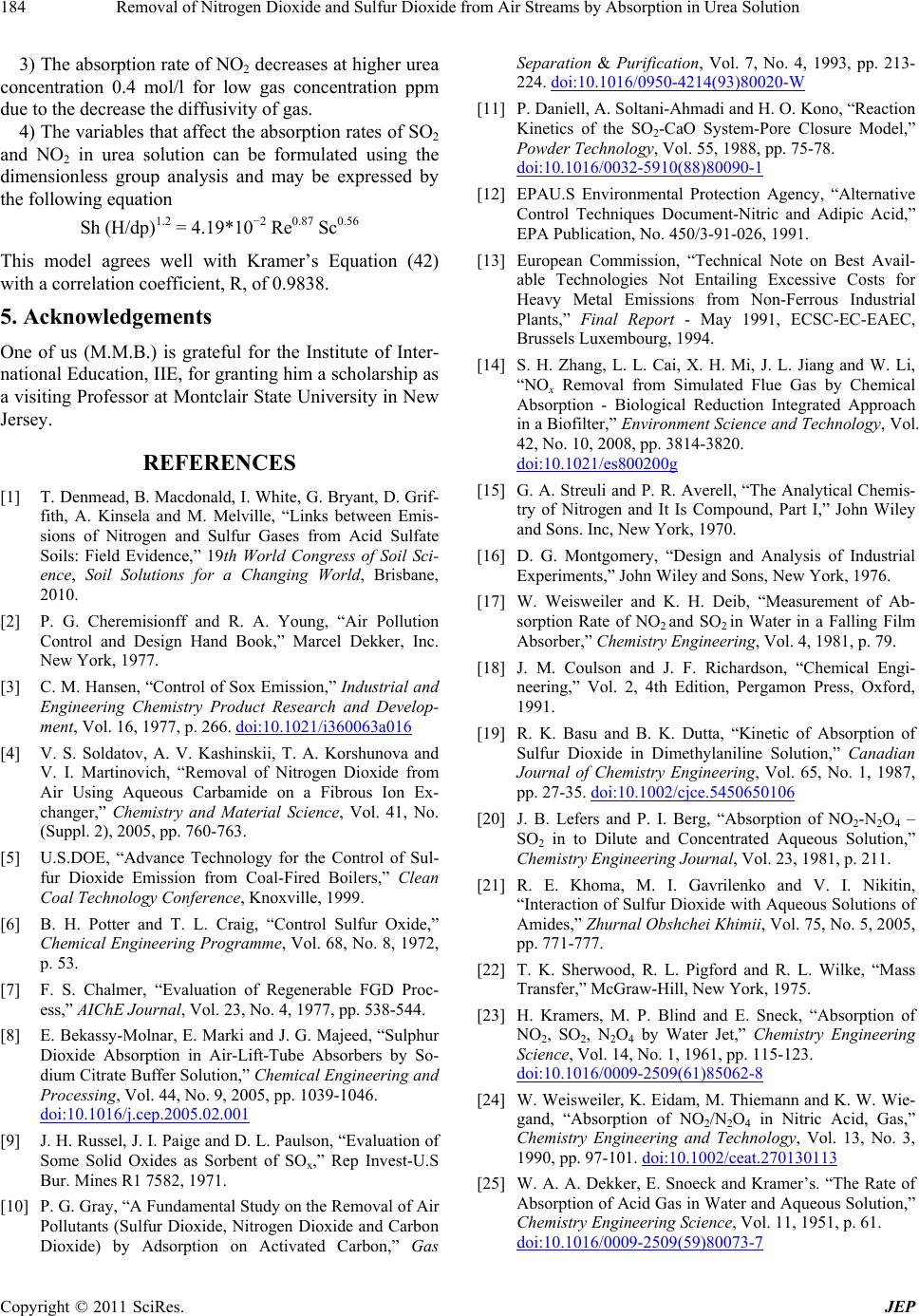
Removal of Nitrogen Dioxide and Sulfur Dioxide from Air Streams by Absorption in Urea Solution
184
3) The absorption rate of NO2 decreases at higher urea
concentration 0.4 mol/l for low gas concentration ppm
due to the decrease the diffusivity of gas.
4) The variables that affect the absorption rates of SO2
and NO2 in urea solution can be formulated using the
dimensionless group analysis and may be expressed by
the following equation
Sh (H/dp)1.2 = 4.19*10−2 Re0.87 Sc0.56
This model agrees well with Kramer’s Equation (42)
with a correlation coefficient, R, of 0.9838.
5. Acknowledgements
One of us (M.M.B.) is grateful for the Institute of Inter-
national Education, IIE, for granting him a scholarship as
a visiting Professor at Montclair State University in New
Jersey.
REFERENCES
[1] T. Denmead, B. Macdonald, I. White, G. Bryant, D. Grif-
fith, A. Kinsela and M. Melville, “Links between Emis-
sions of Nitrogen and Sulfur Gases from Acid Sulfate
Soils: Field Evidence,” 19th World Congress of Soil Sci-
ence, Soil Solutions for a Changing World, Brisbane,
2010.
[2] P. G. Cheremisionff and R. A. Young, “Air Pollution
Control and Design Hand Book,” Marcel Dekker, Inc.
New York, 1977.
[3] C. M. Hansen, “Control of Sox Emission,” Industrial and
Engineering Chemistry Product Research and Develop-
ment, Vol. 16, 1977, p. 266. doi:10.1021/i360063a016
[4] V. S. Soldatov, A. V. Kashinskii, T. A. Korshunova and
V. I. Martinovich, “Removal of Nitrogen Dioxide from
Air Using Aqueous Carbamide on a Fibrous Ion Ex-
changer,” Chemistry and Material Science, Vol. 41, No.
(Suppl. 2), 2005, pp. 760-763.
[5] U.S.DOE, “Advance Technology for the Control of Sul-
fur Dioxide Emission from Coal-Fired Boilers,” Clean
Coal Technology Conference, Knoxville, 1999.
[6] B. H. Potter and T. L. Craig, “Control Sulfur Oxide,”
Chemical Engineering Programme, Vol. 68, No. 8, 1972,
p. 53.
[7] F. S. Chalmer, “Evaluation of Regenerable FGD Proc-
ess,” AIChE Journal, Vol. 23, No. 4, 1977, pp. 538-544.
[8] E. Bekassy-Molnar, E. Marki and J. G. Majeed, “Sulphur
Dioxide Absorption in Air-Lift-Tube Absorbers by So-
dium Citrate Buffer Solution,” Chemical Engineering and
Processing, Vol. 44, No. 9, 2005, pp. 1039-1046.
doi:10.1016/j.cep.2005.02.001
[9] J. H. Russel, J. I. Paige and D. L. Paulson, “Evaluation of
Some Solid Oxides as Sorbent of SOx,” Rep Invest-U.S
Bur. Mines R1 7582, 1971.
[10] P. G. Gray, “A Fundamental Study on the Removal of Air
Pollutants (Sulfur Dioxide, Nitrogen Dioxide and Carbon
Dioxide) by Adsorption on Activated Carbon,” Gas
Separation & Purification, Vol. 7, No. 4, 1993, pp. 213-
224. doi:10.1016/0950-4214(93)80020-W
[11] P. Daniell, A. Soltani-Ahmadi and H. O. Kono, “Reaction
Kinetics of the SO2-CaO System-Pore Closure Model,”
Powder Technology, Vol. 55, 1988, pp. 75-78.
doi:10.1016/0032-5910(88)80090-1
[12] EPAU.S Environmental Protection Agency, “Alternative
Control Techniques Document-Nitric and Adipic Acid,”
EPA Publication, No. 450/3-91-026, 1991.
[13] European Commission, “Technical Note on Best Avail-
able Technologies Not Entailing Excessive Costs for
Heavy Metal Emissions from Non-Ferrous Industrial
Plants,” Final Report - May 1991, ECSC-EC-EAEC,
Brussels Luxembourg, 1994.
[14] S. H. Zhang, L. L. Cai, X. H. Mi, J. L. Jiang and W. Li,
“NOx Removal from Simulated Flue Gas by Chemical
Absorption - Biological Reduction Integrated Approach
in a Biofilter,” Environment Science and Technology, Vol.
42, No. 10, 2008, pp. 3814-3820.
doi:10.1021/es800200g
[15] G. A. Streuli and P. R. Averell, “The Analytical Chemis-
try of Nitrogen and It Is Compound, Part I,” John Wiley
and Sons. Inc, New York, 1970.
[16] D. G. Montgomery, “Design and Analysis of Industrial
Experiments,” John Wiley and Sons, New York, 1976.
[17] W. Weisweiler and K. H. Deib, “Measurement of Ab-
sorption Rate of NO2 and SO2 in Water in a Falling Film
Absorber,” Chemistry Engineering, Vol. 4, 1981, p. 79.
[18] J. M. Coulson and J. F. Richardson, “Chemical Engi-
neering,” Vol. 2, 4th Edition, Pergamon Press, Oxford,
1991.
[19] R. K. Basu and B. K. Dutta, “Kinetic of Absorption of
Sulfur Dioxide in Dimethylaniline Solution,” Canadian
Journal of Chemistry Engineering, Vol. 65, No. 1, 1987,
pp. 27-35. doi:10.1002/cjce.5450650106
[20] J. B. Lefers and P. I. Berg, “Absorption of NO2-N2O4 –
SO2 in to Dilute and Concentrated Aqueous Solution,”
Chemistry Engineering Journal, Vol. 23, 1981, p. 211.
[21] R. E. Khoma, M. I. Gavrilenko and V. I. Nikitin,
“Interaction of Sulfur Dioxide with Aqueous Solutions of
Amides,” Zhurnal Obshchei Khimii, Vol. 75, No. 5, 2005,
pp. 771-777.
[22] T. K. Sherwood, R. L. Pigford and R. L. Wilke, “Mass
Transfer,” McGraw-Hill, New York, 1975.
[23] H. Kramers, M. P. Blind and E. Sneck, “Absorption of
NO2, SO2, N2O4 by Water Jet,” Chemistry Engineering
Science, Vol. 14, No. 1, 1961, pp. 115-123.
doi:10.1016/0009-2509(61)85062-8
[24] W. Weisweiler, K. Eidam, M. Thiemann and K. W. Wie-
gand, “Absorption of NO2/N2O4 in Nitric Acid, Gas,”
Chemistry Engineering and Technology, Vol. 13, No. 3,
1990, pp. 97-101. doi:10.1002/ceat.270130113
[25] W. A. A. Dekker, E. Snoeck and Kramer’s. “The Rate of
Absorption of Acid Gas in Water and Aqueous Solution,”
Chemistry Engineering Science, Vol. 11, 1951, p. 61.
doi:10.1016/0009-2509(59)80073-7
Copyright © 2011 SciRes. JEP